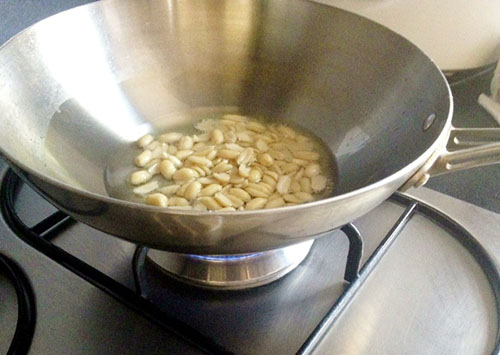
Outside of China, think Chinese food and one of the first dishes that probably comes to mind is kungpao (or gongbao)chicken. The sweet-salty-spicy flavor in the chicken and the crunch in the mouth from the peanuts is a winning combination. It’s a popular take-out food and sometimes comes in those adorable New York style cardboard boxes that feature in many a Hollywood movie. It is best savored with steaming hot rice.
The dish is said to have been named after Qing Dynasty official Ding Baozhen, whose official title was Gongbao, which literally means “palace guardian.” During the Cultural Revolution, the name of the dish was considered politically incorrect because of its association with an imperial officer, so it was renamed hongbao jiding (fast-fried chicken cubes) or hula jiding (chicken cubes with seared chillies). By the 1980s, the original name was restored to the dish.

This classic gongbao jiding of Szechuan cuisine involves a tongue-numbing experience, thanks to generous portions of flaming hot Szechuan peppercorms. It is not a sensation that agrees with most foreigners, so over the years variations have been made on the original recipe to make it milder and more suited for non-Chinese palates. In the United States, a ban on the import of Szechuan peppers was in effect from 1968 to 2005 because the peppers were known to carry a tree disease that could infect other crops. The ban resulted in yet a another form of the recipe that does not use the peppercorns and is now widely accepted as the American-style gong bao chicken.
When we tried to replicate this staple Chinese dish at home recently, we also chose to omit the fistfuls of Szechuan pepper that were recommended. However, we used a packet of Chinese gongbao jiding mix, and this resulted in a fiery flavor without numbing our taste buds. The gongbao jiding packet is available in any grocery store or market, local or for expats, for approximately RMB5. Picking up a ready-mix seasoning packet is a good way to introduce yourself to Chinese cooking, and eliminates the need for buying several different ingredients that you will use only very little of.

Dice 300 grams of skinless chicken breast. Tenderize it on a plate by marinating in salt or a teaspoon of fish sauce and dusting three tablespoons of cornstarch on it. The use of cornstarch is a classic food preparation technique in Chinese cuisine, but I learned that if you are out of cornstarch, a mixture of egg white and 1 teaspoon of cooking oil will do too. Sprinkle all over the diced chicken, mix well and let stand five to ten minutes.
Meanwhile, wash and peel 50 grams of uncooked shelled peanuts, and dry them thoroughly. Dice the vegetables: a medium carrot, small cucumber or zucchini, and one leek stalk. Slice a few cloves of garlic and set everything aside.
Heat up a wok and drizzle 3 tablespoons of vegetable oil. Wait for the oil to heat up and then roast the dry peanuts in the oil until golden brown. Keep stirring constantly to infuse the oil with the peanut flavor. When the peanuts are ready, take them out of the oil and set aside.

Stir-fry the chicken cubes and when they turn translucent but before they are cooked through, add half a packet of the gongbao jiding mix and half a teaspoon of white sugar to season. Mix thoroughly to coat all the chicken pieces. The seasoning is thick but not lumpy and you should not need to add any liquid to the chicken. But if your mixture is too dry, add water a teaspoonful at a time until the chicken is well-coated in the paste. Put the peanuts back in and stir.
Add the carrots, continue to stir-fry. It is okay if the carrots are not cooked until they are tender. The crunch complements the texture of the peanuts. Then pour in the leeks and cucumbers or zucchini, and stir some more. Lastly, throw in the garlic for a quick stir. The garlic does not need to brown; you want the pungent flavor to still be evident.
If you would like to use Szechuan peppers as in the original recipe, then the first step, before roasting the peanuts, will be to infuse the oil with the peppercorns. Take five tablespoons of peppercorns and flash fry them in very hot oil. Take out all the peppers and set them aside. Continue with the peanuts and the rest of the ingredients, and then when you have ladled the finished dish on to a plate, sprinkle the pre-fried peppercorns on top of the chicken.
Bon appetit! If you decide to try out this recipe, let us know how you liked it by leaving a comment below.
Photos by Dana Cosio-Mercado
Dana is the beijingkids Shunyi Correspondent. Originally from the Philippines, she moved to Beijing in 2011 (via Europe) with her husband, two sons and Rusty the dog. She enjoys writing, photography, theater, visual arts, and trying new food. In her free time, she can be found exploring the city and driving along the mountain roads of Huairou, Miyun and Pinggu.



